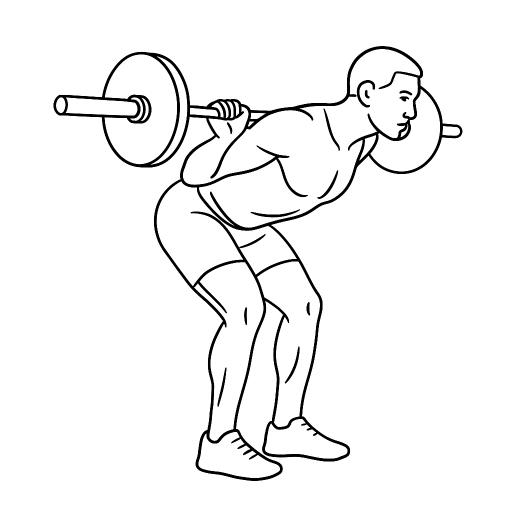Good Mornings
A great exercise to really get things going from toe to cowlick

How to Perform the Good Morning Exercise
Begin by placing a barbell safely across your upper traps, gripping the bar just outside shoulder width. Stand with feet hip-width apart and a slight bend in the knees to protect the joints. Brace your core as if preparing to be struck in the stomach, then hinge at the hips, sending your buttocks backward while keeping the chest lifted and spine neutral. Lower your torso until it’s nearly parallel to the floor, feeling a deep stretch through the hamstrings. Keep the weight balanced over the arches of your feet and maintain tension through the back and glutes. Pause briefly at the bottom, then drive your hips forward to return to standing, squeezing the glutes at the top to complete each repetition.
Safety Precautions
Always warm up your posterior chain before loading heavier weight; five minutes of light banded hip hinges and dynamic hamstring drills will help protect your lower back and preserve ATP for the main set. Inspect your bar, collars, and rack for stability, and use safety pins set just below your reachable depth if you must bail out. Focus on controlled movement throughout—avoid rounding or hyperextending the spine—and never sacrifice form for extra load. If you experience any sharp discomfort in your lumbar region or hamstrings, rack the bar immediately and reassess your position. Supportive gear like a belt can help maintain intra-abdominal pressure, but should never replace a strong, braced core.
Muscles Worked
The Good Morning is a powerful hinge movement that primarily targets the hamstrings and gluteus maximus, while also engaging the spinal erectors and the muscles of the lower back to stabilize the torso. As you hinge forward, your hamstrings control the descent under tension, and your glutes activate to drive the return to standing. Your erector spinae and multifarious work isometrically to keep your spine in a safe, neutral alignment, and your core muscles—including the transverse abdominal—brace to resist unwanted flexion. Secondary engagement comes from the adductors for hip stability and the calves for balance, making the Good Morning an exceptional exercise for building posterior-chain strength and improving functional hip hinge mechanics.
Begin by placing a barbell safely across your upper traps, gripping the bar just outside shoulder width. Stand with feet hip-width apart and a slight bend in the knees to protect the joints. Brace your core as if preparing to be struck in the stomach, then hinge at the hips, sending your buttocks backward while keeping the chest lifted and spine neutral. Lower your torso until it’s nearly parallel to the floor, feeling a deep stretch through the hamstrings. Keep the weight balanced over the arches of your feet and maintain tension through the back and glutes. Pause briefly at the bottom, then drive your hips forward to return to standing, squeezing the glutes at the top to complete each repetition.
Safety Precautions
Always warm up your posterior chain before loading heavier weight; five minutes of light banded hip hinges and dynamic hamstring drills will help protect your lower back and preserve ATP for the main set. Inspect your bar, collars, and rack for stability, and use safety pins set just below your reachable depth if you must bail out. Focus on controlled movement throughout—avoid rounding or hyperextending the spine—and never sacrifice form for extra load. If you experience any sharp discomfort in your lumbar region or hamstrings, rack the bar immediately and reassess your position. Supportive gear like a belt can help maintain intra-abdominal pressure, but should never replace a strong, braced core.
Muscles Worked
The Good Morning is a powerful hinge movement that primarily targets the hamstrings and gluteus maximus, while also engaging the spinal erectors and the muscles of the lower back to stabilize the torso. As you hinge forward, your hamstrings control the descent under tension, and your glutes activate to drive the return to standing. Your erector spinae and multifarious work isometrically to keep your spine in a safe, neutral alignment, and your core muscles—including the transverse abdominal—brace to resist unwanted flexion. Secondary engagement comes from the adductors for hip stability and the calves for balance, making the Good Morning an exceptional exercise for building posterior-chain strength and improving functional hip hinge mechanics.
Updated: August 13, 2025 10:19
Comments
You must log in to post a comment.